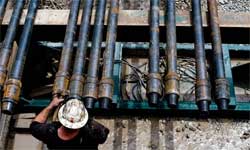
New research on the safety of hydraulic fracturing (fracking) suggests new wells should not be dug within 600 meters of a water aquifer because underground fractures can extend about that far from a dug well. According to a report from UK’s The Guardian newspaper, researchers and geologists at Durham University have determined that underground fractures […]
 New research on the safety of hydraulic fracturing (fracking) suggests new wells should not be dug within 600 meters of a water aquifer because underground fractures can extend about that far from a dug well.
New research on the safety of hydraulic fracturing (fracking) suggests new wells should not be dug within 600 meters of a water aquifer because underground fractures can extend about that far from a dug well.
According to a report from UK’s The Guardian newspaper, researchers and geologists at Durham University have determined that underground fractures typically extended no more than 588 meters up and down from a well underground.
During the fracking process, when a drill and high-pressure rush of drilling fluids flows through a well and reaches an underground shale bed, the rock is broken apart and natural gas is released. When the rock is blasted apart, one residual effect of that process is the creation of an underground fissure extended in opposite directions from the initial rupture.
These fractures are believed to be partially responsible for allowing drilling fluid and gases produced in the process to escape collection at the surface, instead finding natural paths underground. People living within the safe range discovered from this latest research would likely face a greater risk of contamination related to fracking. Researchers determined the maximum range of these fractures created in the fracking process rarely reach more than 588 meters. Also, it is “extremely unlikely” that shallow aquifers underground would become contaminated if fracking is conducted at depths between 2 and 3 kilometers. That does not however, the discount entirely the threat to shallow fracking contamination.
Durham researchers have published their study in the latest edition of the journal Marine and Petroleum Geology. It concludes that fracking-related contamination can happen at shallow depths if there are failures in the cement and steel wells built to access the underground rock at deeper depths. If these well shafts fail, the gases and waste drilling fluid can escape at shallower depths, too.
While this study appears to discredit the notion that deep fracking drilling is responsible for water contamination with drilling fluids and methane gas created in the process, it does believe that most contamination of water aquifers – usually about 1- to 2 kilometers below the surface – is the result of faulty drilling.
In the U.S., fracking drilling is booming and domestic natural gas production has sent prices of the resource tumbling but that hasn’t put a damper on the effort to collect more gas through this controversial process.
Thousands of wells have been dug in just the last few years and as more drilling activity is ordered and allowed, the more likely it is that wells will impede upon the safe zone outlined in this study. While many states have allowed liberal fracking drilling, restrictions around watersheds and municipal water supplies seem to respect the unknown nature of the impact of fracking-related contamination.


